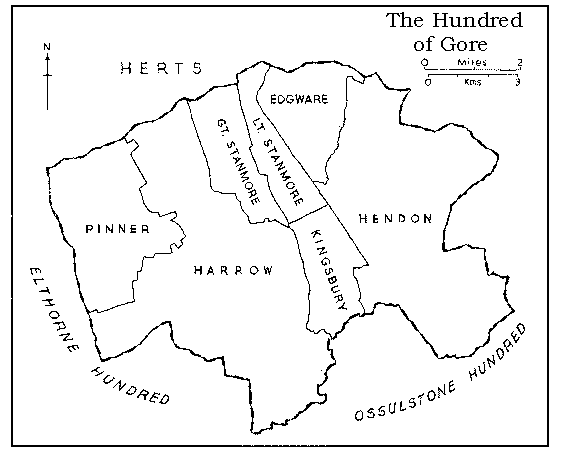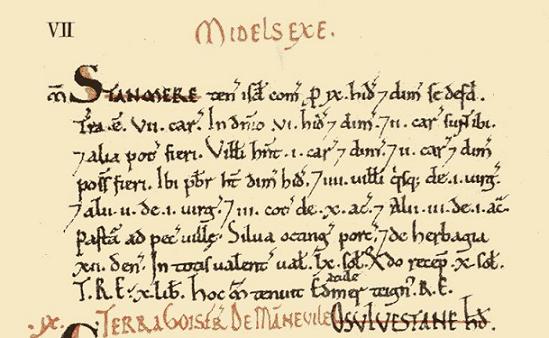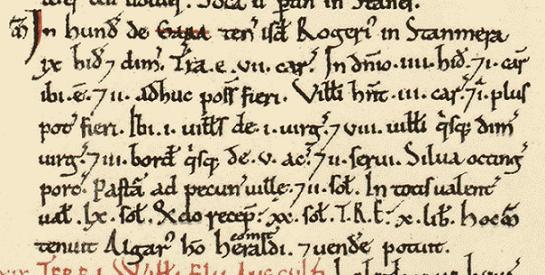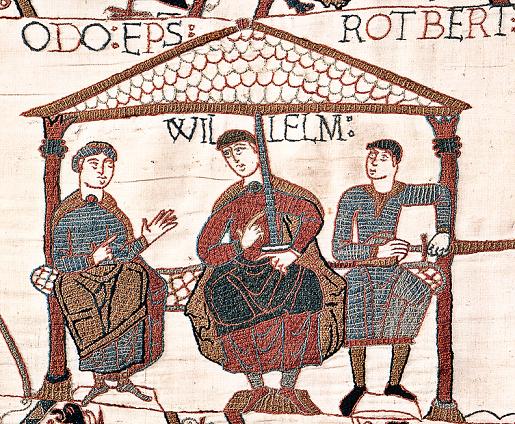William the Conqueror (center) sits next to his half brother Robert "Rotbert", Count of Mortain and landowner of Great Stanmore in a scene on the Bayeux Tapestry. Williams full brother Odo sits to his right
Stanmore was lucky enough to get not one, but two mentions in the Domesday book. This was because Stanmore was in fact made up of two manors.
The first one was called Stanmere and was owned by Robert count of Mortain who was William the Conqerors half brother. Robert was one of the known participants at the Battle of Hastings and at the time of the Domesday Book was one of the greatest landholders in England. This village later became known as Great Stanmore.
The second manor was called Stanmera and was owned by Roger de Rames, this village later became known as Little Stanmore. In 1086 both Stanmore’s were in the hundred of Gore. A hundred is term introduced by the Saxons and was a geographic division used to divide a larger region into smaller administrative areas.
Middlesex was divided into six Hundreds, and Both Stanmores were included in the fifth, the Hundred of Gore, from Anglo-Saxon ‘Gara’ meaning corner of land. The hundred of Gore was then made up of five manors: Harrow, Hendon, Kingsbury, and the two manors of Stanmore, at the time Pinner was a Chapelry of Harrow.

It covered an area in the north of the county and contained the following parishes and settlements.
In 1086, King William I A.K.A William the Conqueror wanted to assess the value of his conquered kingdom 20 years after defeating Harold at the Battle of Hastings,
So he sent official government inspectors around England to ask questions in local courts. Fixed questions were asked which provided extensive records of landholders, their tenants, the amounts of woodland, meadow, animals, fish and ploughs on the land and other resources. Also noted were any buildings present like churches, castles, mills, salthouses, and the like and more importantly how much the land was worth and therefore how much tax he could charge. It was not a census of the population, and the individuals named in it are almost exclusively land holders.
The questions were asked three times to see what changes had happened over time. The commissioners were authorised to search out the value of the land before the invasion, then after, and finally in 1086, they were also requested to find the landowners, who were the ones to be taxed.
The questions included:
What is the manor called?
Who held it in the time of King Edward?
Who holds it now?
How many hides (a land measurement)?
How much has been added or taken away from the manor?
How much has or had each freeman and each sokeman?
How many plough teams?
How many freemen, sokemen, villans, cottars and slaves?
How much wood, meadow and pasture?
How many mills and fisheries?
and How much was the whole worth in 1066, and how much now in 1086.
All of these results to the questions were handwritten into the Domesday Book by scribes. They were written in Medieval Latin, which was the most common form of Latin used in the middle ages.

Great Stanmore
Taxable units: Taxable value 9.5 geld units. Payments of 0.05 meadow, pasture, woodland.
Value: Value to lord in 1066 £10. Value to lord in 1086 £3. Value to lord c. 1070 £0.5.
Households: 6 villagers. 1 priest. 6 cottagers.
Ploughland: 7 ploughlands (land for). 2 lord's plough teams. 1 lord's plough teams possible. 1.5 men's plough teams.
Other resources: 6.5 lord's lands. Woodland 800 pigs. 0.5 church lands.
Lord in 1066: Edmer Ator.
Overlord in 1066: King Edward.
Lord in 1086: Count Robert of Mortain.
Tenant-in-chief in 1086: Count Robert of Mortain.

Little Stanmore
Total population: 14 households.
Total tax assessed: 9.5 geld units.
Taxable units: Taxable value 9.5 geld units. Payments of 0.1 meadow, pasture, woodland.
Value: Value to lord in 1066 £10. Value to lord in 1086 £3. Value to lord c. 1070 £1.
Households: 9 villagers. 3 smallholders. 2 slaves.
Ploughland: 7 ploughlands (land for). 1 lord's plough teams. 2 lord's plough teams possible. 3 men's plough teams.
Other resources: 4.0 lord's lands. Woodland 800 pigs.
Lord in 1066: Algar, Earl Harold's man.
Overlord in 1066: Earl Harold.
Lord in 1086: Roger of Rames.
Tenant-in-chief in 1086: Roger of Rames.
Items crossed through in red are not corrections but indicate key items – names and places, they are a sort of index.
Although The volumes have been rebound on several occasions the original Domesday Books have survived intact for over 900 years. From the 1740s onwards they were held, with other Exchequer records, in the Chapter House of Westminster Abbey. In 1859 they were placed in the new Public Record Office, London. They are now held at The National Archives at Kew. The ancient Domesday chest, in which they were kept in the 17th and 18th centuries, is also preserved at Kew.
